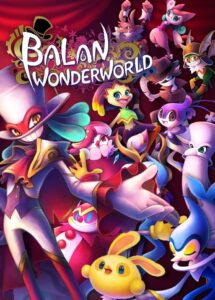
Spending money on most AAA games seems like it can cost an arm and a leg for college students with a $60 price tag.
However, most of the time this expense is made up for by the quality and duration of the game in question.
That is not how “Balan Wonderworld” operates.
Released on March 26, “Balan Wonderworld” is a multi-platform developed by Square Enix.
Initially, when the project was first teased, Square Enix fans were excited as Yuji Naka, lead programmer of “Sonic the Hedgehog” and Naoto Ohshima, designer of the titular hedgehog, were in charge of direction and character design.
The game’s art style also seemed reminiscent of the Sega Dreamcast cult class “Nights into Dreams,” leading to speculation that the game would be a spiritual successor of sorts.
Not much gameplay was shown off during development and there was very little fanfare leading up to the game’s release.
Usually, this lack of publicity is due to a publisher’s expectations of failure for a project.
Upon release, what was advertised as a full $60 AAA game contained the polish and quality of a $5 shovelware platforming game.
The game starts up nicely with a well-polished, clean cutscene as is expected from Square Enix games. This quality disappears after about three minutes when the cutscene ends and players are thrown into a hub world with little to no explanation about any of their objectives other than going to the level select and entering the first stage.
Upon entering the stage, players are not given any direction and are expected to fumble their way through lackluster platforming and figure out the destination for themselves.
The only instructions given to the player are how to use the various power-up costumes that are collected in the different levels. Yet, even the power-ups make the game more tedious and limited than it already was.
On a controller, a developer has the choice of four different face buttons to choose from to assign different actions.
Rather than assign different actions to each individual button, rather, the game uses all four buttons for the same action.
Without a power-up, all four face buttons cause the character to jump and with a power-up all four buttons use the special move, removing your ability to jump in the process.
Players can stock up multiple power-ups and change between them at any given time, but this requires the character to completely freeze and complete a second and a half long animation for changing costumes which completely stops the momentum of platforming.
The story is almost non-existent and is only barely implied through small cutscenes that usually occur at the beginning and end of a set of levels.
Supposedly, the story revolves around your character helping other people restore their hopes and dreams by guiding them down the right path and freeing them from the darkness in their heart instilled by the villain Lance.
The only way for the player to fully understand the story is to read the companion novel released on the same day as the game.
Once the character is rescued, the player and the rescued individual engage in a weird motion-captured dance sequence which feels even more out of place than a lot of the other events that occur.
Apparently the game is supposed to be themed around musicals and theater, but again this is a fact that is hard to discern from anything you are presented throughout the game other than the dance sequences.
There are other small, weird occurrences that happen throughout the game such as NPCs vanishing if the player gets too close to their model.
Each character only has two sound clips for their jump actions which becomes a nuisance when you are playing a platformer that requires a lot of jumping.
Strangely, after the game’s release, its Metacritic score was very high which was attributed to several positive review scores that seemed to be given by users with similar names, leading many to theorize that the developer was trying to increase positive reviews of the game as some publishers have done in the past.
Perhaps there is some behind-the-scenes goings on that limited development and prevented Square Enix from producing their next prominent title, but with what was released, it should be avoided in its entirety.

